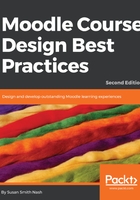
Learning outcomes
One of the best ways to start planning your course is by thinking about what you'd like your students to be able to do when they successfully complete it. At the same time, it is good to envision how they should demonstrate their new knowledge or skill. What your students are able to do as a result of taking the course are the learning outcomes of the course. Both terms refer to the notion of a course, that is, they focus not just on the content to be covered, but also on the skills, abilities, beliefs, and attitudes that result upon completion of the course.
It is important to place your learning objectives on your course's front page so that they are constantly in the mind of your students. Here is an example from the course, Trends in Tourism. Notice how the learning objectives appear on the front page, and they are accompanied by a photo to help call attention to them, without being distracting:

Learning outcomes encompass the knowledge, skills, and abilities that the students should gain on completing the course. Learning outcomes are known by other terms as well. They are often referred to as course outcomes, course objectives, learning objectives, and student-learning outcomes. In all cases, they are important because they shape every aspect of your course, from selecting content and activities to creating assessments that determine whether the course or the learning program was effective.
As you consider what you would like your students to do, you are incorporating a student-centric approach that puts more emphasis on how they should do something as opposed to what they should do, which results in a more active approach. Instead of thinking about what you'd like to teach, you're considering how to facilitate the learning process.